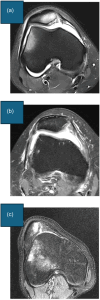Adapting the Dejour classification of trochlear dysplasia from qualitative radiograph- and CT-based assessments to quantitative MRI-based measurements
- PMID: 39555850
- PMCID: PMC12310096
- DOI: 10.1002/ksa.12539
Adapting the Dejour classification of trochlear dysplasia from qualitative radiograph- and CT-based assessments to quantitative MRI-based measurements
Abstract
Purpose: To adapt the current D. Dejour trochlear dysplasia classification (v2.0) to only rely on quantitative magnetic resonance imaging (MRI) measurements (v3.0) to maximize objectivity and repeatability.
Methods: A consecutive series of adult knee MRIs were divided into objective patellar instability (OPI, n = 127) or controls (n = 103; isolated meniscal tears) and postprocessed with multiplanar reconstruction (MPR) to standardize the sagittal plane and ensure true lateral views. Thresholds for sulcus angle, lateral trochlear inclination (LTI) and central bump were established using regression tree models to distinguish OPI from controls. The sensitivity and specificity of sulcus angle and LTI combinations to diagnose OPI were then evaluated, and the combination yielding the highest sensitivity was selected as basis for trochlear dysplasia classification. Finally, sulcus angle and LTI measurability and presence of a central bump >5 mm were used to grade dysplasia as low, moderate or high.
Results: The regression tree models produced thresholds of ≥157° for sulcus angle and <14° for LTI to distinguish OPI from controls. 'Sulcus angle ≥157° OR LTI < 14°' yielded the highest sensitivity (87%) to diagnose OPI. The quantitative MRI classification was sulcus angle <157° AND LTI ≥ 14° for Type 0 (No dysplasia); (sulcus angle ≥ 157° OR LTI < 14°) AND central bump <5 mm for Type 1 (Low-grade dysplasia); (sulcus angle OR LTI are 'unmeasurable') AND central bump <5 mm for Type 2 (Moderate-grade dysplasia); (sulcus angle ≥ 157° OR 'unmeasurable' OR LTI < 14° OR 'unmeasurable') AND central bump ≥5 mm for Type 3 (High-grade dysplasia).
Conclusion: This MRI classification depends exclusively on quantitative measurements, has excellent interobserver agreement, and yields high sensitivity to diagnose OPI. The MRI imaging protocol with MPR mode and standardized measurements could be quickly adopted and correctly applied by clinicians worldwide in any type of institution to determine the ideal treatment plan.
Level of evidence: Level III.
Keywords: bump; lateral trochlear inclination; magnetic resonance imaging; objective patellar instability; sulcus angle; trochlear dysplasia.
© 2024 The Author(s). Knee Surgery, Sports Traumatology, Arthroscopy published by John Wiley & Sons Ltd on behalf of European Society of Sports Traumatology, Knee Surgery and Arthroscopy.
Conflict of interest statement
D. D. reports personal fees from SBM, outside the submitted work. The remaining authors declare no conflict of interest.
Figures










References
-
- Dejour, D. , Reynaud, P. & Lecoultre, B. (1998) Douleurs et instabilité rotulienne. Essai de classification. Médecine et Hygiène, 56(2217), 1466–1471.
-
- Dejour, H. , Walch, G. , Neyret, P. & Adeleine, P. (1990) [Dysplasia of the femoral trochlea]. Revue de Chirurgie Orthopedique et Reparatrice de l'Appareil Moteur, 76(1), 45–54. - PubMed
MeSH terms
Grants and funding
LinkOut - more resources
Full Text Sources
Medical
Research Materials

